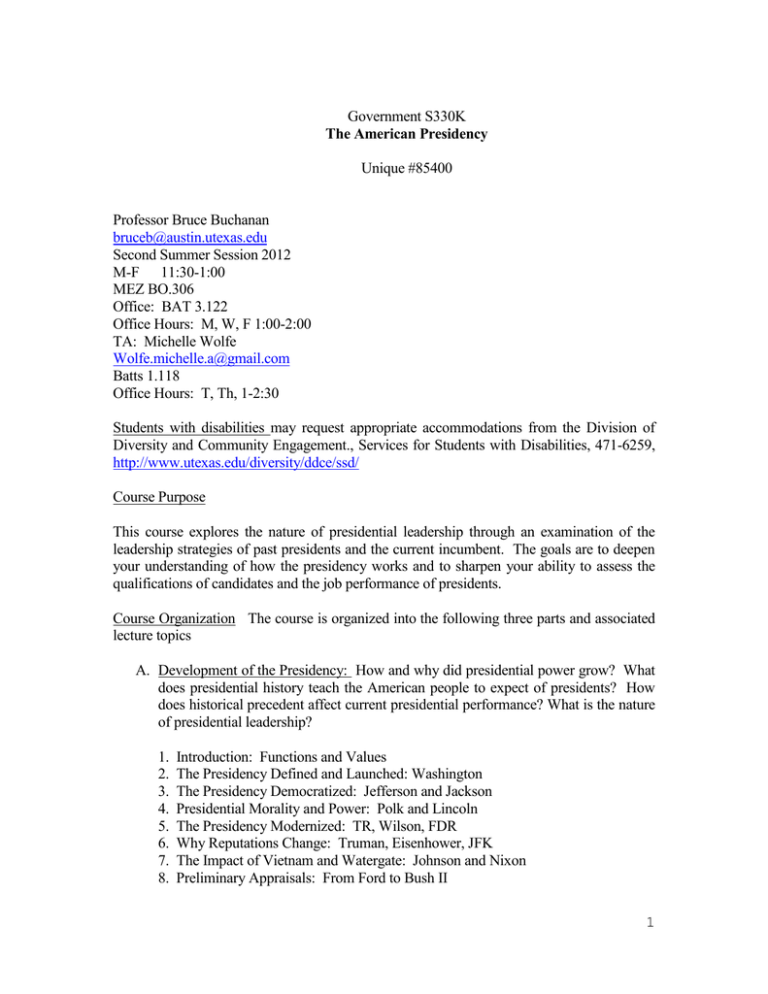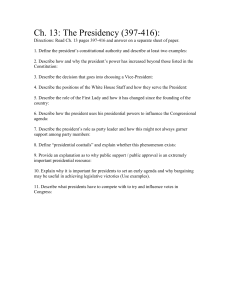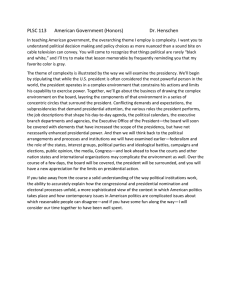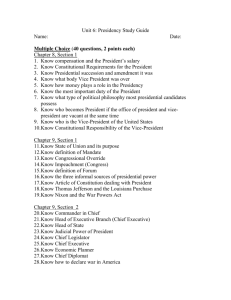Government S330K Unique #85400 Professor Bruce Buchanan
advertisement

Government S330K The American Presidency Unique #85400 Professor Bruce Buchanan bruceb@austin.utexas.edu Second Summer Session 2012 M-F 11:30-1:00 MEZ BO.306 Office: BAT 3.122 Office Hours: M, W, F 1:00-2:00 TA: Michelle Wolfe Wolfe.michelle.a@gmail.com Batts 1.118 Office Hours: T, Th, 1-2:30 Students with disabilities may request appropriate accommodations from the Division of Diversity and Community Engagement., Services for Students with Disabilities, 471-6259, http://www.utexas.edu/diversity/ddce/ssd/ Course Purpose This course explores the nature of presidential leadership through an examination of the leadership strategies of past presidents and the current incumbent. The goals are to deepen your understanding of how the presidency works and to sharpen your ability to assess the qualifications of candidates and the job performance of presidents. Course Organization The course is organized into the following three parts and associated lecture topics A. Development of the Presidency: How and why did presidential power grow? What does presidential history teach the American people to expect of presidents? How does historical precedent affect current presidential performance? What is the nature of presidential leadership? 1. 2. 3. 4. 5. 6. 7. 8. Introduction: Functions and Values The Presidency Defined and Launched: Washington The Presidency Democratized: Jefferson and Jackson Presidential Morality and Power: Polk and Lincoln The Presidency Modernized: TR, Wilson, FDR Why Reputations Change: Truman, Eisenhower, JFK The Impact of Vietnam and Watergate: Johnson and Nixon Preliminary Appraisals: From Ford to Bush II 1 9. The Lessons of Presidential History B. Current Presidential Operations: What are the responsibilities of the institution and what resources are available to meet them? What are the “state of the art” strategies for deploying resources to achieve a president’s political and policy objectives? How can the quality of a president’s performance in office be reasonably measured? 1. 2. 3. 4. 5. 6. 7. 8. Introduction: The Grounds for Judgment The Campaign for Office The Domestic Policy Arena Confronting Congress Media: The Classic Dilemma The Budget and Economic Policy Foreign Policy Presidential Competence and the Public Interest C. Evaluating Presidential Candidates: What are the grounds for choice among presidential candidates? How important is character, relative to issue positions and track-record, in appraising the qualifications of candidates? How well does the presidential selection system work? 1. Introduction: Five Dimensions of Presidential Leadership 2. Candidate Qualifications 3. Character: Avoiding Troubled Candidates D. Course Conclusion: The Division of Labor Student Responsibilities 1. Two short-answer essay mid-term examinations (30% of grade each) 2. Comprehensive two-question essay final examination (40% of grade) 3. Regular attendance (After 2 “free” absences course grade subject to decrease by ½ letter grade per subsequent absence). Required Readings J. Pfiffner (2011) The Modern Presidency, 6th ed. M. Nelson, ed. (2012) The Evolving Presidency, 4th ed. F. Greenstein (2009) The Presidential difference, 3d.ed. Regular newspaper reading—presidency stories in New York Times, Washington Post or Wall Street Journal. 2 WEEKLY READING AND EXAM SCHEDULE Complete readings by date indicated 1. July 9 N,xiii-xv; 1-74 G, 1-41 P, 1-17 2. July 16 N, 77-211 G, 43-89 P, 18-55 ***FIRST MID-TERM FRIDAY JULY 20*** 3. July 23 N, 211-283 G, 91-143 P, 56-130 July 30 G, 145-188 P, 131-224 ***SECOND MID-TERM FRIDAY AUGUST 3 5. August 6 P, 230-262 G, 191-231 ***FINAL EXAMINATION*** Saturday August 11, 9-12 noon 3




